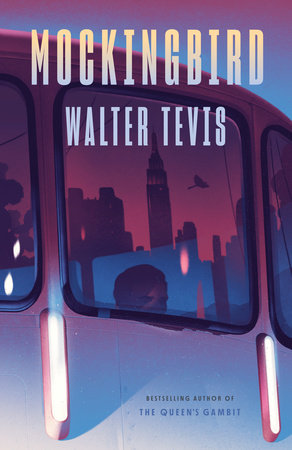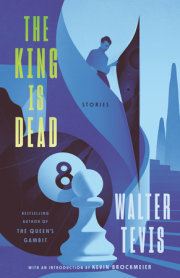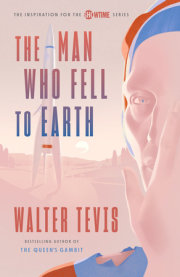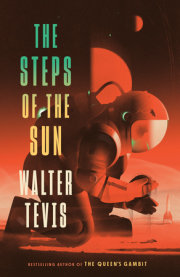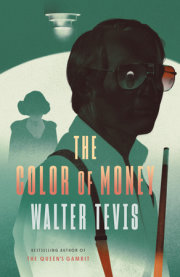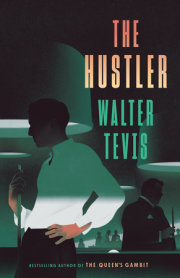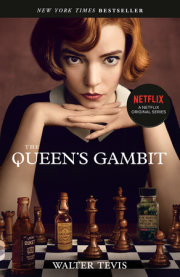Chapter 1
Spofforth
Walking up Fifth Avenue at midnight, Spofforth begins to whistle. He does not know the name of the tune nor does he care to know; it is a complicated tune, one he whistles often when alone. He is naked to the waist and barefoot, dressed only in khaki trousers; he can feel the worn old paving beneath his feet. Although he walks up the middle of the broad avenue he can see patches of grass and tall weeds on either side of him where the sidewalk has long before been cracked and broken away, awaiting repairs that will never be made. From these patches Spofforth hears a chorus of diverse clickings and wing rubbings of insects. The sounds make him uneasy, as they always do this time of year, in spring. He puts his big hands into his trouser pockets. Then, uncomfortable, he takes them out again and begins to jog, huge and light-footed, athletic, up toward the massive form of the Empire State Building.
The doorway to the building had eyes and a voice; its brain was the brain of a moron—single-minded and insensitive. “Closed for repairs,” the voice said to Spofforth as he approached.
“Shut up and open,” Spofforth said. And then, “I am Robert Spofforth. Make Nine.”
“Sorry, sir,” the door said. “Couldn’t see . . .”
“Yes. Open up. And tell the express elevator to be down for me.”
The door was silent for a moment. Then it said, “Elevator’s not working, sir.”
“Shit,” Spofforth said. And then, “I’ll walk up.”
The door opened and Spofforth walked in and headed across the dark lobby toward the stairway. He muted the pain circuits in his legs and lungs, and began to climb. He was no longer whistling; his elaborate mind had become fixed narrowly now upon his annual intent.
When he reached the edge of the platform, as high above the city as one could stand, Spofforth sent the command to the nerves in his legs and the pain surged into them. He wobbled slightly from it, high and alone in the black night, with no moon above him and the stars dim. The surface underfoot was smooth, polished; once years before Spofforth had almost slipped. Immediately he had thought, in disappointment, If only that would happen again, at the edge. But it did not.
He walked to within two feet of the platform’s limit, and with no mental signal, no volition, no wish for it to happen, his legs stopped moving and he found himself, as always, immobilized, facing Fifth Avenue uptown, over a thousand dark feet above its hard and welcome surface. Then he urged his body forward in sad and grim desperation, focusing his will upon the desire to fall forward, merely to lean his strong and heavy body, his factory-made body, out, away from the building, away from life. Inwardly he began to scream for movement, picturing himself tumbling in slow motion, gracefully and surely, to the street below. Yearning for that.
But his body was not—as he knew it would not be—his own. He had been designed by human beings; only a human being could make him die. Then he screamed aloud, throwing his arms out at his sides, bellowing in fury over the silent city. But he could not move forward.
Spofforth stood there, alone on top of the tallest building in the world, immobilized, for the rest of the June night. Occasionally the lights of a thought bus would be visible, slightly larger than stars, below him, moving slowly up and down the avenues of an empty city. There were no lights on in the buildings.
And then, as the sun began to illuminate the sky over the East River to his right and over Brooklyn, to which no bridges ran, his frustration began to ebb. Had he been given tear ducts he would, then, have found the release of tears; but he could not cry. The light became brighter; he could see the outlines of the empty buses below him. He could see a tiny Detection car moving up Third Avenue. And then the sun, pale in the June sky, burst up over an empty Brooklyn and sparkled on the water of the river as fresh as at the dawn of time. Spofforth took a step backward, away from the death he sought and had been seeking all his long life, and the anger that had possessed him began to ebb with the rising sun. He would go on living, and he could bear it.
He climbed down the dusty staircase slowly at first. But by the time he reached the lobby his footsteps were brisk, self-assured, full of artificial life.
As he left the building he told the speaker on the doorway, “Don’t let the elevator be repaired. I prefer the climb.”
“Yes, sir,” the door said.
Outside, the sun was shining brightly and there were a few humans on the street. An old black woman in a faded blue dress happened to brush Spofforth’s elbow, looked up dreamily at his face. When she saw his marking as a Make Nine robot she immediately averted her eyes and mumbled, “I’m sorry. I’m sorry, sir.” She stood near him, at a loss. She had probably never seen a Make Nine before and only knew about them from her early training.
“Go on,” he said gently. “It’s all right.”
“Yes, sir,” she said. She fumbled in her dress pocket and pulled out a sopor and took it. Then she turned and shuffled off.
Spofforth walked briskly, in sunshine, back down toward Washington Square, toward New York University, where he worked. His body never tired. Only his mind—his elaborate, labyrinthine, and lucid mind—understood the meaning of fatigue. His mind was always, always tired.
Spofforth’s metal brain had been constructed and his body grown from living tissue at a time, long before, when engineering was in decline but the making of robots was a high art. That art too would soon decline and wither; Spofforth himself had been its highest achievement. He was the last of a series of a hundred robots designated Make Nine, the strongest and most intelligent creatures ever made by man. He was also the only one programmed to stay alive despite his own wishes.
A technique existed for making a recording of every neural pathway, every learning pattern of an adult human brain and transferring that recording to the metal brain of a robot. This technique had been used only for the Make Nine series; all of the robots in that series had been equipped with altered copies of the living brain of a single man. That man was a brilliant and melancholy engineer named Paisley—although Spofforth was never to know that. The network of information bits and interconnections that made up Paisley’s brain had been recorded on magnetic tapes and stored in a vault in Cleveland. What happened to Paisley after his mind was copied no one ever knew. His personality, his imagination, and his learning had all been recorded on tapes when he was forty-three, and afterward the man was forgotten.
The tapes were edited. The personality was removed from them as much as was possible without harming the “useful” functions. Just what was “useful” about a mind had been determined by engineers less imaginative than Paisley himself. The memory of the life was erased, and with it much of the learning, although the syntax and vocabulary of English remained on the tapes. They contained, even after editing, a near-perfect copy of an evolutionary miracle: a human brain. Some unwanted things from Paisley remained. The ability to play the piano was in the tapes, but needed a body with arms and hands to be manifest. But when the body was made there would be no piano for it to play.
Unwanted by the engineers who had made the recording, but unavoidable, were fragments of old dreams, yearnings, anxieties. There was no way to rid the tapes of these without damaging other functions.
The recording was transferred electronically to a silvery ball, nine inches in diameter, made up of thousands of layers of nickel-vanadium, spun and shaped by automatic equipment. The ball was placed in the head of a body cloned especially for it.
The body was grown carefully in a steel tank, at what had once been an automobile plant in Cleveland. The result was perfect—tall, powerful, athletic, beautiful. It was a black man in the prime of life, with fine muscles, powerful lungs and heart, kinky black hair, clear eyes, a beautiful, thick-lipped mouth, and large, strong hands.
Some human things had been altered: the aging process had been programmed to stop at the physical development of a thirty-year-old—which was where the body had arrived after four years in the steel tank. It was equipped to control its own pain responses, and was, within limits, self-regenerating. It could, for instance, continue to grow new teeth, or new fingers or toes, as needed. It would never go bald or develop faulty vision or cataracts or thickened arteries or arthritis. It was, as the genetic engineers were fond of saying, an improvement upon the work of God. Since none of the engineers believed there was a God, however, their self-praise was unsound.
Spofforth’s body had no reproductive organs. “To avoid distractions,” one of the engineers said. The earlobes on each side of the magnificent head were jet black to signify to any human being who might be awed by this imitation man that he was, after all, only a robot.
Like the Frankenstein monster, he was given active life by electrical shock; he emerged from his tank fully grown and able to talk, a bit thickly at first. In the vast and cluttered factory room where he was brought into awareness his dark eyes looked around him with excitement and life. He was on a stretcher when he first experienced the power of consciousness enveloping his nascent being like a wave, becoming his being. His constricted throat gagged and then cried out at the force of it—at the force of being in the world.
He was named Spofforth by one of the few men who still knew how to read. The name came at random, from an ancient Cleveland telephone directory: Robert Spofforth. He was a Make Nine robot, the most sophisticated single piece of equipment ever to be fashioned by human ingenuity.
Part of his first year’s training sent him to monitoring the hallways and doing minor chores at a dormitory school for human beings. It was a place where the young were taught the ways of their world: Inwardness, Privacy, Self-fulfillment, Pleasure. It was there that he saw the girl in the red coat and fell in love.
Through that winter and through the early spring the girl always wore a scarlet coat with a black velvet collar, as black as anthracite, as black as her hair against her white skin. Her red lipstick matched her coat. In those days almost no one wore lipstick anymore and it was a wonder that she owned some. She looked beautiful wearing it. When Spofforth first saw her, on his third day at the dormitory compound, she was almost seventeen. His mind photographed her instantly and for all time. This picture was to become a major part of the sadness that began, in springtime, in June, to settle deeply into his manufactured and potent being.
By the time he was a year old Spofforth understood quantum mechanics, robotic engineering, and the history of state-owned corporations in North America—all taught to him by audio-visuals and by robot tutors—but he did not know how to read. Nor did he know anything about human sexuality, not consciously; although there were dim yearnings in what once would have been called his heart. Sometimes when he was alone and in darkness, his stomach would flutter for a moment disturbingly. He was beginning to know that in him somewhere was a buried life, a life of feelings. On the first warm evenings of his first June he began to be seriously disquieted by it. Walking from one dormitory building to another, late at night, he would hear the sounds of katydids in the trees in the warm Ohio evening and there would be a strange, uncomfortable pressure in his chest. He worked hard at the dormitories, doing much menial work for what was called “training”; but the work seldom really occupied his attention and melancholy had begun to fall on his spirit.
Some of the Make Four workers would break down occasionally; there never seemed to be enough repair equipment to keep up with minor malfunctions. A few old men were kept around to fill in when that happened. One of these was a derelict named Arthur, who usually smelled of synthetic gin and who never wore socks. He always spoke to Spofforth, in a partly friendly, partly mocking way, when they would pass each other in the dormitory hallways or on one of the gravel paths outside the buildings. Once, while Spofforth was emptying ashtrays in the cafeteria and Arthur was sweeping up, Arthur stopped working, leaned on his broom, and said, “Bob,” and Spofforth looked up from his work. “Bob,” Arthur said, “you’re a moody one. Didn’t know they made moody robots.”
Spofforth was unsure whether he was being teased or not. He continued carrying a stack of plastic ashtrays, filled with the morning’s array of marijuana butts, to the garbage can in the corner of the big room. The students had left a short time before for a televised lecture on yoga.
“Never saw a sad robot before,” Arthur said. “Is that because of those black ears?”
“I’m a Make Nine robot,” Spofforth said defensively. He was still very young, and conversations with humans could make him uneasy.
“Nine!” Arthur said. “That’s pretty high, isn’t it? Hell the Andy that runs this school is only a Seven.”
“Andy?” Spofforth said, holding the pile of ashtrays.
“Yeah, android. Andys is what we called you things—you guys—when I was a kid. Weren’t so many of you then. Weren’t so smart either.”
“Do you mind that? That I’m smart?”
“No,” Arthur said. “Shit no. People are so fucking dumb these days it makes you want to cry.” He looked away, and then gave a little push to his broom. “Smart is smart. I’m glad there’s some around somewhere.” He stopped sweeping and made a loose gesture around the big empty room as though the students were still there. “I wouldn’t want any of those dumb illiterates to be running the show when they get out of here.” His wrinkled face was filled with contempt. “Hypnotized freaks. Jack-offs. They ought to put ’em in a coma and feed ’em pills.”
Copyright © 2022 by Walter Tevis. All rights reserved. No part of this excerpt may be reproduced or reprinted without permission in writing from the publisher.

